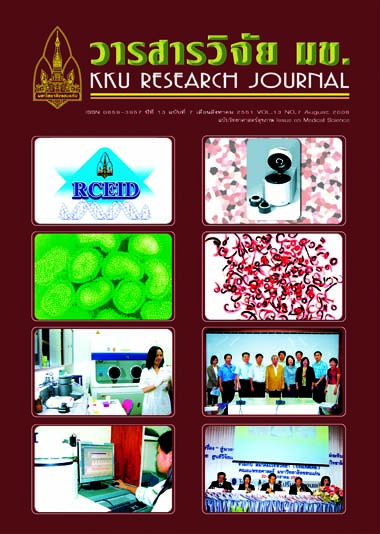The effectiveness of system development of comprehensive and continuity care for HIV/AIDS patients from hospital to home (Thai)
Main Article Content
Abstract
AIDS is a communicable chronic disease, which requires specific care in all aspects, with continuity
from hospital to home and community. At present, the predence of anti-retrovirus drugs (ARV) has helped
prolong the life of AIDS patients. Therefore, the number of people living with HIV/AIDS (PHAs) in Thai
society has grown progressively.
The purpose of this action research was to evaluate the development of hospital-based and community
care systems for PHAs. Data were collected both before and after the development of the hospital-based and
community care systems for PHAs, by means of in-depth interviews, observations, and focus-group discussions.
The participants included hospital staff, PHAs, caregivers, or household members of PHAs and community
leaders of two selected community hospitals. Semi-structured guidelines for in-depth interviews and
focus-group discussions as well as WHOQOL_BREF_THAI were used for data collection. The results are as
follows.
Situation analysis in the pre-action phase assessment showed that the services for HIV/AIDS in
Kumalasai Hospital were under the guidance of the hospital AIDS committee. The committee composed of
representatives of all hospital service units chaired by the hospital director, whereas there was no such committee
at Ban Phai Hospital. The primary functions of this committee were to define policies and develop guidelines
for HIV/AIDS care, as well as to monitor these services. The two hospitals provided mostly biomedical care
and supported the HIV/AIDS group’s activities in collaboration with the District HIV/AIDS “Chalerm Prakiat
Center” to provide psychosocial and economic issues. During the action phase, with the participation of each
unit of the hospital, The activities developed were the following. Firstly was the organization of a training
program for health care providers to update their knowledge on HIV/AIDS, especially in terms of
anti-retrovirus drugs. Secondly a study tour to Wangsapoong Hospital, Loei Province and self-empowerment
processes which contributed to the health system improvement activities including flow chart diagram of
services for PHAs heath care standards for PHAs, and the establishment of an information center were
organized. The center served as the coordinating body for holistic care and ensured the continuity of services.
The community-based care for PHAs was developed by the cooperative effort of the primary care unit (PCU),
hospital, families and community with the support of the research project. The activities began with convening
workshops for PHAs, community leaders, and health care providers to identify the existing problems and
develop problem-solving measures. The knowledge and experience sharing session was given by Chumpae
Hospital and Tambon Administrative Organization which had a clearer picture of how to operate HIV/AIDS
programs in the community. The hospitals and the communities agreed to launch the community care program
for PHAs. The major activity was the establishment of an AIDS fund with the purpose of providing economic
relief to PHAs. The finances for this fund were made possible through the community industry fund. There was
an increasing acceptance in the community towards the PHAs. However, some PHAs, especially in the urban
area, still disclosed themselves, therefore the community could not contribute much to help them. The present
activities were mainly campaigning to prevent the spread of HIV/AIDS, as well as surveillance over the risk
group and case findings. The community also planned to conduct fund-raising activities to support PHAs. This
strategy was developed on the community consensus basis. Economy was identified as a major problem of
PHAs, and the communities were able to manage. The post action assessment found that quality of life of
PHAs was improved in all aspects. This might be due to the development of holistic care at the hospital which
was responsive to needs and increased PHAs’ trust towards the system. Economic support such as rising local
resources, continuity and expansion of existing activities was also a key for success. The most important issue
was the health care development through the participatory problem solving process of all sectors contributing
to the successfulness of the trend towards the quality of life of PHAs.
Article Details
How to Cite
Sanchaisuriya, P., Laohasiriwong, W., Boonyaleepun, S., Saengsuwan, J., Rittirod, T., Kasalaraksa, P., & Siripakarn, P. (2017). The effectiveness of system development of comprehensive and continuity care for HIV/AIDS patients from hospital to home (Thai). Asia-Pacific Journal of Science and Technology, 13(7), 797–806. retrieved from https://so01.tci-thaijo.org/index.php/APST/article/view/83644
Section
Research Articles
References
-


